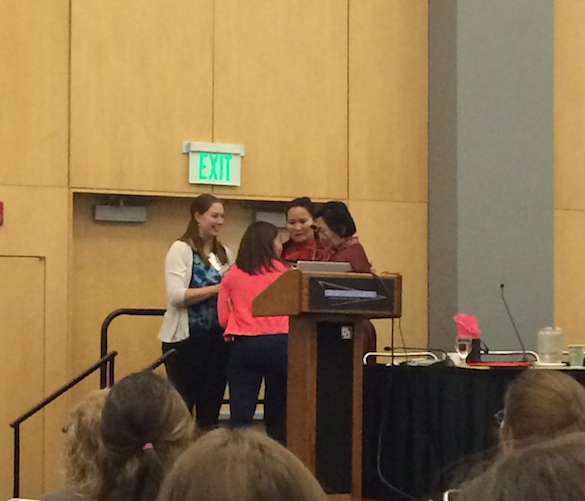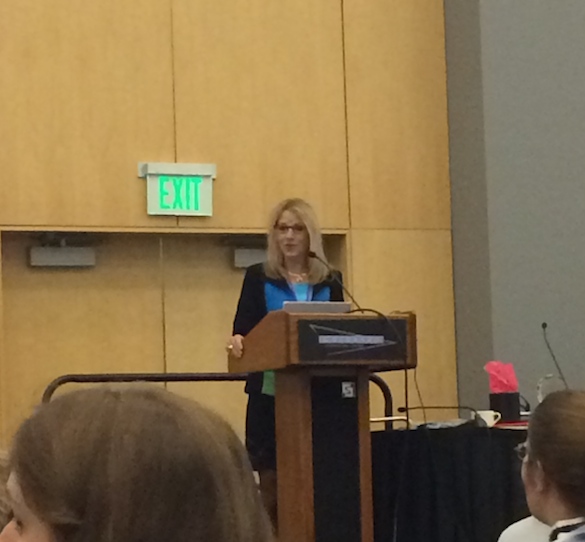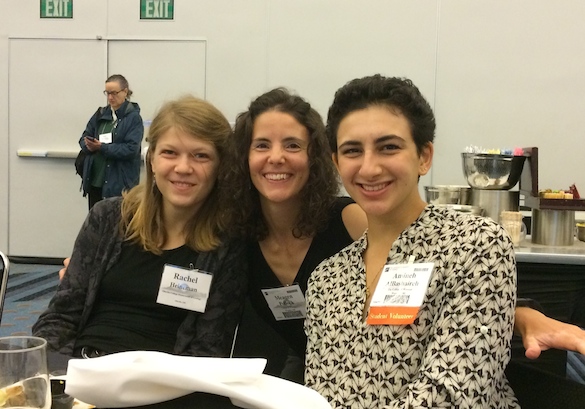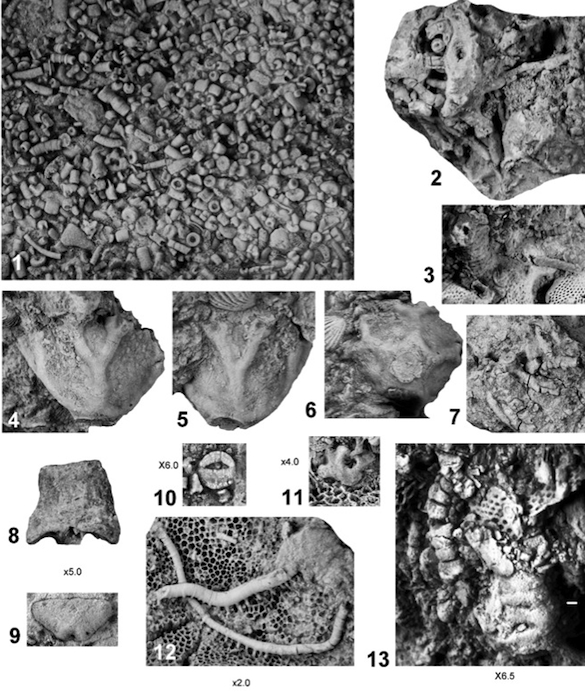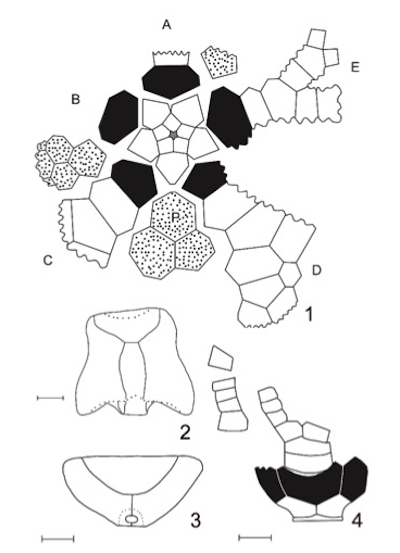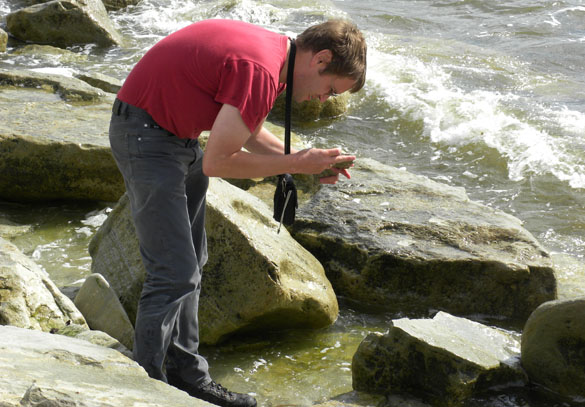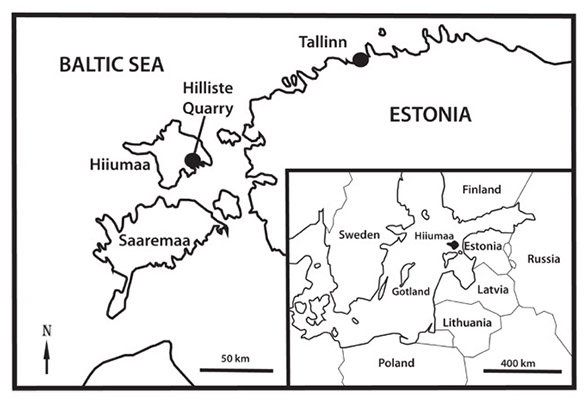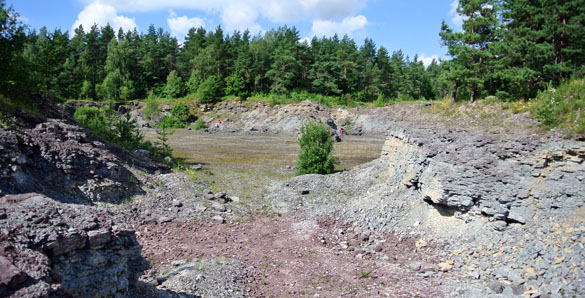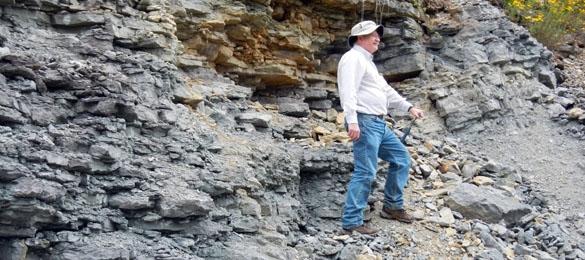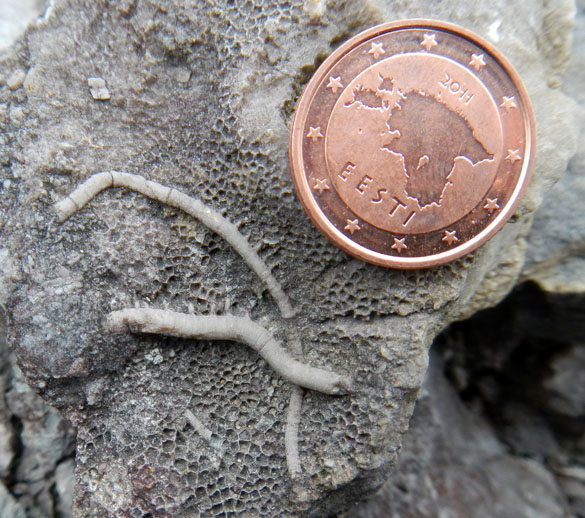 These little brachiopods were also in the recent gift package from Clive Champion, our English brachiopod expert and friend. They tested my photographic skills, being too large for our photomicroscope and at the limit of resolution for my camera with its extension tubes. They are the athyridide Hustedia radialis (Phillips, 1836) from the Chadian-Arundian Limestone (Viséan, Lower Carboniferous) exposed near Wetton, Staffordshire, England. Brachiopods of this size are often referred to as “micromorph“, with some debate as to whether they are dwarfed adults or juveniles. With this fauna the consensus is the former.
These little brachiopods were also in the recent gift package from Clive Champion, our English brachiopod expert and friend. They tested my photographic skills, being too large for our photomicroscope and at the limit of resolution for my camera with its extension tubes. They are the athyridide Hustedia radialis (Phillips, 1836) from the Chadian-Arundian Limestone (Viséan, Lower Carboniferous) exposed near Wetton, Staffordshire, England. Brachiopods of this size are often referred to as “micromorph“, with some debate as to whether they are dwarfed adults or juveniles. With this fauna the consensus is the former.
Athyridide brachiopods are “spire-bearing”, meaning they have complexly-spiraled lophophore supports (brachidia) inside their shells. The lophophore is a tentacular device that creates a water current and traps organic bits from it for nutrition. These tiny critters thus had surprisingly elaborate feeding systems. The first paleontologist to grind through these minuscule shells to sort out the twists and turns of their microscopic brachidia is a hero of science.
 Hustedia radialis was named in 1836 by one of the most important English geologists of the 19th Century, John Phillips (1800-1874). He originally called it Terebratula radialis, a common genus name applied at the time to biconvex brachiopods with pedicle openings (the hole for the attaching stalk visible at the pointy end of the shell).
Hustedia radialis was named in 1836 by one of the most important English geologists of the 19th Century, John Phillips (1800-1874). He originally called it Terebratula radialis, a common genus name applied at the time to biconvex brachiopods with pedicle openings (the hole for the attaching stalk visible at the pointy end of the shell).
 He named it in the second volume of his Geology of Yorkshire series.
He named it in the second volume of his Geology of Yorkshire series.
 See if you can find the two figures of Terebratula radialis in Plate XII of the book. (Hint: small, triangular and ribbed!)
See if you can find the two figures of Terebratula radialis in Plate XII of the book. (Hint: small, triangular and ribbed!)
John Phillips was born in Wiltshire in 1800. His mother was a sister of the famous William “Strata” Smith, another founding father of modern geology. Phillips father and mother died when he was only seven years old, so William Smith took over raising him, despite his genteel poverty. Phillips traveled with Smith throughout England in the course of making Smith’s famous 1815 map. Phillips had a spotty formal education, but was clearly a quick study. By 1824 he was organizing museum fossil collections in Yorkshire, and in 1826 he became keeper of the Yorkshire natural history museum. Phillips then advanced very quickly, helping organize the new British Association for the Advancement of Science, becoming a professor of geology at King’s College London, and then at the age of 34 he was elected a Fellow of the Royal Society. All the while he kept up a prodigious rate of publication. The honors and positions continued for Phillips, with him eventually becoming a Reader of Geology at Oxford University. A remarkable career with such an unpromising start.
 Phillips published the first geological time scale in 1841, inventing the term “Mesozoic” in the process. The above clip is from Phillips (1841, p. 160).
Phillips published the first geological time scale in 1841, inventing the term “Mesozoic” in the process. The above clip is from Phillips (1841, p. 160).
 Here is his 1860 version of the geological time scale (Phillips, 1860, p. 51).
Here is his 1860 version of the geological time scale (Phillips, 1860, p. 51).
After an April 1874 dinner at All Souls College in Oxford, John Phillips fell down a flight of stone steps, dying the next day. No doubt but for this fall he would have continued producing geological work into the next decade.
References:
Brunton, C.H.C. 1984. Silicified brachiopods from the Viséan of County Fermanagh, Ireland (III). Rhynchonellids, spiriferids and terebratulids. Bulletin of the British Museum (Natural History), Geology 38: 27–130.
Brunton, C.H.C. and Champion, C. 1974. A Lower Carboniferous brachiopod fauna from the Manifold Valley, Staffordshire. Palaeontology 17: 811–840.
Mottequin, B., Sevastopulo, G. and Simon, E. 2015. Micromorph brachiopods from the late Asbian (Mississippian, Viséan) from northwest Ireland (Gleniff, County Sligo). Bulletin of Geosciences 90: 307-330.
Phillips, J. 1836. Illustrations of the geology of Yorkshire, Part 2. The mountain limestone district. 253 pp. John Murray, London.
Phillips, J. 1841. Figures and Descriptions of the Palaeozoic Fossils of Cornwall, Devon and West Somerset. 231 pp. Longman, Brown, Green and Longmans, London.
Phillips, J. 1860. Life on the earth: its origin and succession. 224 pp. Macmillan and Company, London.
 Fun feature of that last reference: Google Books scanned a personal copy of Stephen Jay Gould, a famous American paleontologist and evolutionary theorist.
Fun feature of that last reference: Google Books scanned a personal copy of Stephen Jay Gould, a famous American paleontologist and evolutionary theorist.
 On one of the front pages is this penciled note: ‘Unreadable, dull’ – Charles Darwin to [unknown] 15/1/61. [UPDATE: See comment from Katherine Marenco below.]
On one of the front pages is this penciled note: ‘Unreadable, dull’ – Charles Darwin to [unknown] 15/1/61. [UPDATE: See comment from Katherine Marenco below.]
